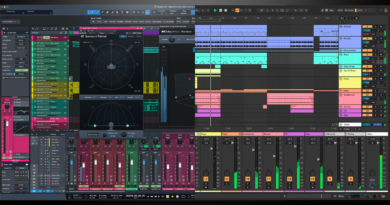BAR Guide: What is Compression?
Let’s demystify this critical audio effect and explore how you can harness the power of Compression in your own productions.
Understanding Compression
A Vital Tool for Modern Music Production Compression is often hailed as one of the most essential tools in music production, yet it can be one of the most misunderstood.
Whether you’re mixing a massive track that’s destined for club speakers or crafting a delicate acoustic piece for streaming, knowing how to effectively use compression is key to achieving a polished sound.

What is Compression?
Compression is a process used in audio production to manage the dynamic range of a sound. Dynamic range is the difference between the loudest and quietest parts of an audio signal.
A compressor reduces the volume of loud sounds or amplifies quiet sounds by narrowing or “compressing” an audio signal’s dynamic range.

Why use Compression?
Consistency: Compression helps smooth out an audio track by making the volume more consistent. This is crucial for vocals and other dynamic instruments whose volume can vary dramatically throughout a performance.
Punch and Clarity: Applying compression can make a sound punchier and more upfront. This is especially useful in dense mixes, where you need each element to cut through clearly.
Control: Compressors allow you to control the peaks in loud passages, which can prevent distortion and help maintain overall balance in the mix.
Glue: When used on a mix bus, compression can help “glue” all parts of a mix together, creating a unified sound that feels cohesive and polished.

Key Parameters of a Compressor
To use a compressor effectively, you need to understand its basic controls. Threshold: The level at which the compressor starts to reduce the volume. If an audio signal exceeds this level, compression will be applied.
Ratio: This parameter determines how much compression is applied. For example, a 4:1 ratio means that if the input level is 4 dB over the threshold, the output signal will be 1 dB over the threshold.

Attack: How quickly the compressor starts to work after the signal surpasses the threshold. A faster attack time is good for taming sharp transients, while a slower attack lets some of the initial transient through, maintaining the natural sound of the instrument.
Release: How quickly the compressor stops affecting the signal after it falls below the threshold. A faster release time can make the compression less noticeable, while a slower release can add smoothness.
Make-up Gain: After compression, the signal can be quieter. Make-up gain allows you to bring the level back up to match the uncompressed signal.
How to Use Compression: Practical Tips

Vocals
Apply a moderate ratio (around 3:1) and set the threshold so that the compressor activates on the louder passages. Adjust the attack to allow some natural dynamics to come through and use the release to keep the vocal smooth and even.

Drums
Drums often benefit from a higher ratio and a faster attack to control the transient spikes and add punch. Experiment with the attack and release to either sharpen the drum hits or blend them smoothly into the mix.

Bass
Use compression to even out the levels and add sustain. A longer release can help sustain a smooth, consistent bass line that supports other mix elements.

Whole Mix
When compressing the entire mix, use a gentle ratio (like 2:1) and a high threshold to avoid over-compressing. This can add the final “glue” to your mix, making everything sound cohesive.
Final Thoughts
Compression is a powerful tool that, when used wisely, can transform a good mix into a great one. Start with subtle settings and gradually adjust as you listen carefully to the impact on your music. Remember, the goal is to enhance the overall sound without squashing the life out of your tracks.
With practice and patience, you’ll find that compression can indeed be a game-changer in your music production toolkit. Happy mixing!











Ain’t gonna lie actually learned a bit from this, nice one